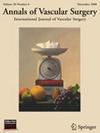Added Diagnostic Value of Intravascular Ultrasound over Venography in “High Risk for Dialysis Circuit Vascular Access Failure” ESRD Patients
IF 1.6
4区 医学
Q3 PERIPHERAL VASCULAR DISEASE
引用次数: 0
Abstract
Background
As a two-dimensional modality, venography has limitations in its capacity to measure lumen caliber and to assess stenotic disease accurately. This has implications in the management of end-stage renal disease (ESRD) patients “no-option” candidates access for arteriovenous fistula (AVF) or graft (AVG) creation secondary to high risk of vascular access failure. The incremental diagnostic and clinical impact of intravascular ultrasound (IVUS) was quantified in this tunneled dialysis catheter-dependent ESRD cohort.
Methods
From January 2024 to February 2025, 14 consecutive “high risk for dialysis circuit vascular access failure” ESRD patients (mean age 56 ± 13 years; 8 male) underwent same-session venography and IVUS. For each interrogated vein, IVUS and venography were compared regarding stenosis grade, venous wall pathology (chronic thrombus, elastic recoil, trabeculae/web formation), and patent central venous outflow. Primary endpoints were IVUS–venography discordance and subsequent change in patient management based on the combined IVUS–venography results. Secondary end points included successful surgical vascular access creation, access maturation at 3–6 months, contrast volume, fluoroscopy time, and procedure-related morbidity.
Results
IVUS was discordant with venography in 7/14 patients (50%): stenosis severity was upgraded in 4 (29%) and downgraded in 3 (21%) based on findings in IVUS. IVUS revealed or confirmed appropriate venous outflow for future vascular access creation in 5/14 patients (36%). Eight of the 14 patients (57%) ultimately underwent AVF/AVG creation after IVUS-guided central venous mapping. At 6 months, 5/8 accesses (63%) were functional for dialysis (4 fistulas, 1 graft). Two accesses (25%) had not been used at the time of analysis, and one fistula (12%) was ligated secondary to infectious complications. Median contrast volume was 51 mL (range 25–127) and median fluoroscopy time was 7.6 min (range 3.0–20.3). No intraprocedural complications during dedicated central venous mapping occurred, and specifically no complications related to IVUS usage were recorded. Two delayed complications occurred in patients who received vascular access as a result of IVUS assessment, and both were managed successfully with endovascular procedures.
Conclusion
In no-option ESRD patients, IVUS revealed changes in stenosis severity in half of the cases compared to standard two-dimensional venography, resulting in permanent dialysis circuit vascular access creation in more than half of the assessed patients, with 63% of these patients reaching vascular access maturation. Routine incorporation of IVUS into salvage central venous mapping may expand durable vascular access options and reduce dialysis catheter dependency.
血管内超声对“透析循环血管通路衰竭高危”ESRD患者的附加诊断价值。
目的:静脉造影作为一种二维方式,在测量管腔口径和准确评估狭窄性疾病方面存在局限性。这对终末期肾脏疾病(ESRD)患者的管理具有重要意义,“无选择”候选通道是继发于高风险血管通路失败的动静脉瘘(AVF)或移植物(AVG)创建。在这个依赖隧道透析导管的ESRD队列中,对血管内超声(IVUS)的增量诊断和临床影响进行了量化。方法:自2024年1月至2025年2月,连续14例“透析循环血管通路失败高危”ESRD患者(平均年龄56±13岁,男性8例)行同期静脉造影和IVUS。对于每条询问的静脉,比较IVUS和静脉造影的狭窄程度、静脉壁病理(慢性血栓、弹性反冲、小梁/网形成)和中心静脉流出通畅。主要终点是ivus -静脉造影不一致,以及基于联合ivus -静脉造影结果的患者管理的后续变化。次要终点包括手术血管通路的成功建立、3-6个月时通路的成熟、造影剂体积、透视时间和手术相关的发病率。结果:IVUS与静脉造影不一致的患者有7/14(50%);根据IVUS的发现,狭窄严重程度升级的有4(29%),降级的有3(21%)。在5/14的患者(36%)中,IVUS显示或证实了适当的静脉流出以用于未来的血管通路创建。14例患者中有8例(57%)最终在ivus引导的中心静脉定位后进行了AVF/AVG创建。6个月时,5/8个通路(63%)可用于透析(4个瘘管,1个移植物)。两个通路(25%)在分析时未使用,一个瘘管(12%)因感染并发症而结扎。中位造影剂体积为51 mL(范围25-127),中位透视时间为7.6 min(范围3.0-20.3)。专用中心静脉测图过程中未发生术中并发症,特别是IVUS使用相关并发症未记录。由于IVUS评估而接受血管通路的患者发生了两例延迟并发症,均通过血管内手术成功处理。结论:在无选择的ESRD患者中,与标准二维静脉造影相比,IVUS显示一半的病例狭窄严重程度发生了变化,超过一半的评估患者产生了永久性透析循环血管通路,其中63%的患者达到了血管通路成熟。常规将IVUS纳入挽救性中心静脉测绘可以扩大持久的血管通路选择并减少透析导管依赖。
本文章由计算机程序翻译,如有差异,请以英文原文为准。
求助全文
约1分钟内获得全文
求助全文
来源期刊
CiteScore
3.00
自引率
13.30%
发文量
603
审稿时长
50 days
期刊介绍:
Annals of Vascular Surgery, published eight times a year, invites original manuscripts reporting clinical and experimental work in vascular surgery for peer review. Articles may be submitted for the following sections of the journal:
Clinical Research (reports of clinical series, new drug or medical device trials)
Basic Science Research (new investigations, experimental work)
Case Reports (reports on a limited series of patients)
General Reviews (scholarly review of the existing literature on a relevant topic)
Developments in Endovascular and Endoscopic Surgery
Selected Techniques (technical maneuvers)
Historical Notes (interesting vignettes from the early days of vascular surgery)
Editorials/Correspondence

 求助内容:
求助内容: 应助结果提醒方式:
应助结果提醒方式:


